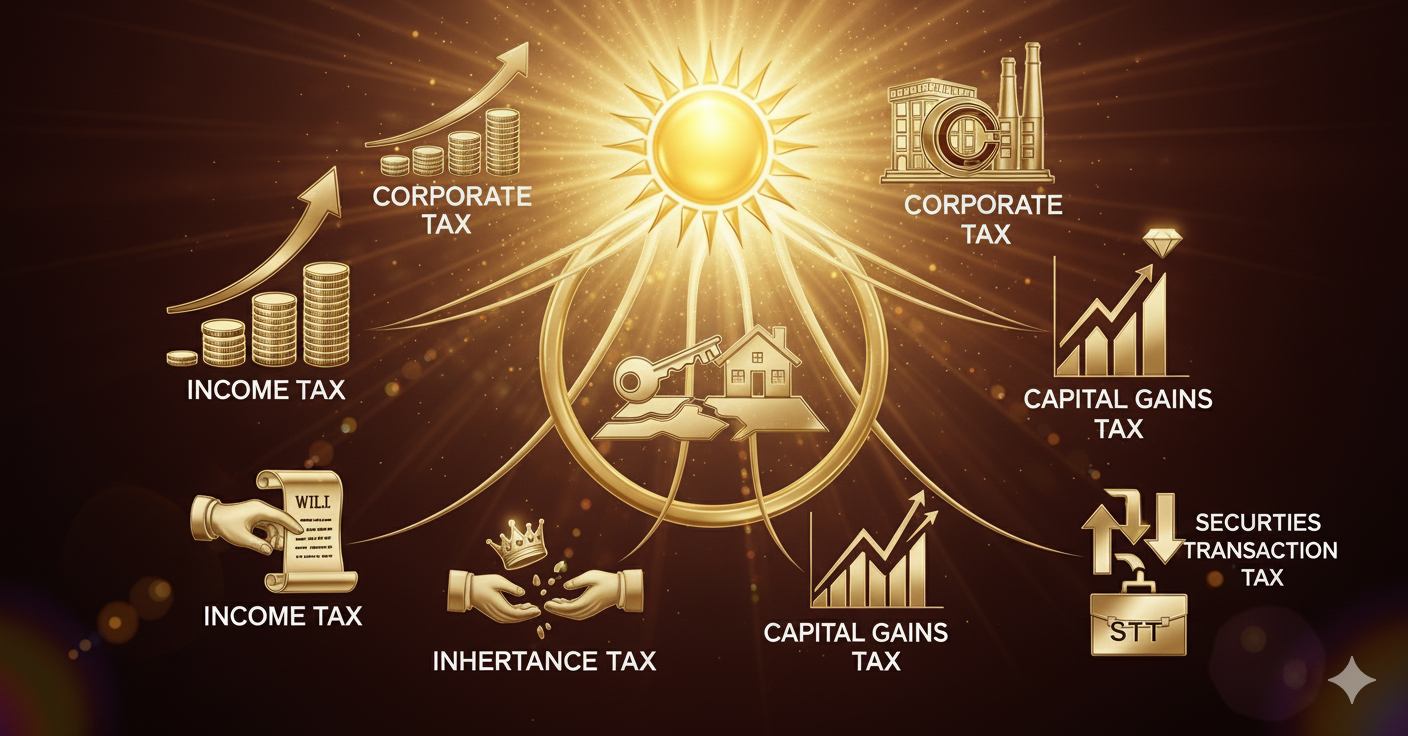Introduction
Taxation is the backbone of any nation’s financial system. It ensures the availability of resources for public expenditure and supports the overall economic framework of a country. In India, the taxation system is broadly divided into direct taxes and indirect taxes. While indirect taxes are levied on goods and services, direct taxes are imposed directly on an individual’s or entity’s income, wealth, or assets. Direct taxes not only contribute significantly to government revenue but also serve as tools for economic regulation and equitable distribution of resources.
This article explores in detail the types of direct taxes in India, their features, significance, challenges, and reforms shaping the taxation landscape.
Meaning of Direct Taxes
A direct tax is a tax levied directly on the income, wealth, or profits of an individual or an organization. The key characteristic of direct taxes is that the burden of payment cannot be shifted to another person. For instance, when an individual pays income tax on their salary, the liability cannot be transferred to anyone else.
Key Features of Direct Taxes:
- Imposed on Income/Wealth – Levied on income, profit, or property of individuals and organizations.
- No Transfer of Burden – The person/entity on whom the tax is imposed must pay it.
- Progressive Nature – Tax rates often increase with income levels, ensuring fairness.
- Legal Obligation – Payment is mandatory under the Income Tax Act and other financial laws.
- Revenue for the Government – Direct taxes form a crucial part of India’s tax revenue, supporting development and welfare schemes.
Types of Direct Taxes in India
Direct taxes in India can be categorized into the following major types:
1. Income Tax
- Definition: Income tax is levied on the income earned by individuals, Hindu Undivided Families (HUFs), firms, and companies.
- Law Governing: The Income Tax Act, 1961.
- Applicability:
- Salaried individuals (on salary income)
- Self-employed professionals
- Businesses and firms
- Companies (Corporate Tax)
- Non-resident Indians on income earned in India
- Structure: Income tax in India is based on progressive tax slabs, where higher income attracts higher rates.
- Components:
- Salary income
- Income from house property
- Profits and gains from business/profession
- Capital gains
- Income from other sources
- Importance: Income tax is the largest contributor to the direct tax revenue of India.
2. Corporate Tax
- Definition: Corporate tax is levied on the net profits of companies operating in India.
- Types:
- Domestic Companies – Companies registered in India are taxed on their global income.
- Foreign Companies – Companies registered outside India but operating in India are taxed only on the income generated within the country.
- Rates: Vary depending on turnover, nature of the company, and government policies. In recent years, corporate tax rates have been reduced to attract foreign investment.
- Additional Components:
- Minimum Alternate Tax (MAT)
- Dividend Distribution Tax (DDT) (abolished in 2020, dividends are now taxed in the hands of investors)
- Role: Corporate tax is critical in ensuring businesses contribute fairly to the nation’s economy.
3. Capital Gains Tax
- Definition: Capital gains tax is levied on the profit earned from the sale of capital assets such as property, shares, bonds, and gold.
- Types:
- Short-Term Capital Gains (STCG) – Assets held for less than 36 months (12 months in case of securities) before being sold.
- Long-Term Capital Gains (LTCG) – Assets held for more than 36 months.
- Exemptions: Certain exemptions are provided under the Income Tax Act if the gains are reinvested in specific assets like property, bonds, or specified government schemes.
- Significance: Encourages savings and investments while ensuring tax on unearned profits.
4. Wealth Tax (Abolished in 2015)
- Definition: Wealth tax was earlier levied on the net wealth of an individual or HUF exceeding a specified limit.
- Current Status: Abolished in 2015 due to low revenue generation and high administrative costs.
- Replacement: Introduced a surcharge on the super-rich instead.
5. Securities Transaction Tax (STT)
- Definition: A tax levied on transactions made in the domestic stock exchanges while trading in securities such as shares, derivatives, and equity-oriented mutual funds.
- Applicability: Paid by investors directly at the time of buying/selling through exchanges.
- Purpose: To generate revenue and regulate speculative trading in markets.
6. Dividend Tax
- Earlier Structure: Earlier, companies had to pay Dividend Distribution Tax (DDT) on dividends declared.
- Current Structure: Post-2020, dividends are taxed in the hands of investors according to their income tax slab.
- Impact: Ensures equitable taxation, aligning dividend income with an individual’s overall income.
7. Gift Tax (Now Covered under Income Tax Act)
- Definition: A tax on money or property received as a gift.
- Current Law: Now governed under Section 56(2) of the Income Tax Act, where gifts above ₹50,000 (other than from relatives) are taxable.
- Exemptions: Gifts received on marriage, inheritance, or from specified relatives are exempt.
8. Estate Duty (Abolished in 1985)
- Definition: Estate duty was a tax on the wealth inherited after the death of a person.
- Current Status: Abolished to simplify taxation and avoid duplication with income tax and wealth tax.
Importance of Direct Taxes
- Revenue Generation – Primary source of income for the government.
- Progressive Nature – Ensures equitable distribution by taxing the rich more.
- Economic Regulation – Used to control inflation and investment.
- Promotes Social Equity – Reduces wealth inequality in society.
- Legal Accountability – Ensures proper accounting and disclosure of income.
Challenges in Direct Tax System
- Tax Evasion – Widespread evasion reduces revenue collection.
- Narrow Tax Base – Only a small percentage of India’s population pays direct taxes.
- Complex Procedures – Tax compliance remains complicated for common citizens.
- Administrative Costs – Ensuring collection and monitoring involves high costs.
- Globalization Issues – Taxing multinational corporations effectively is challenging.
Reforms in Direct Taxation
- Direct Tax Code (DTC) – Proposed to simplify tax laws but yet to be fully implemented.
- Digital Taxation – Expanding tax base through online filing and monitoring.
- Lower Corporate Tax Rates – Introduced to attract investment.
- Faceless Assessment – Reduces human interaction to minimize corruption.
- Rationalization of Tax Slabs – Periodic revision of slabs to balance revenue and fairness.
Conclusion
Direct taxes form the foundation of India’s revenue system and are essential for financing welfare schemes, infrastructure, and defense. They reflect the principle of equity and progressiveness, ensuring that individuals and corporations contribute according to their capacity. Although India has abolished some forms of direct taxes like wealth tax and estate duty, the existing structure—comprising income tax, corporate tax, capital gains tax, and others—remains central to public finance.
The ongoing reforms, simplification of laws, and expansion of the tax base are expected to strengthen the direct taxation system in the coming years, making it more transparent, efficient, and inclusive.




